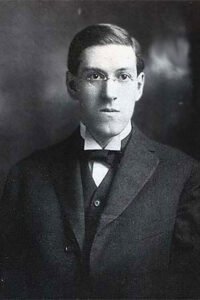
At the Mountains of Madness
Steel head, jointed rods, gasoline motor, collapsible wooden derrick, dynamiting paraphernalia, cording, rubbish-removal auger, and sectional piping for bores five inches wide and up to one thousand feet deep all formed, with needed accessories, no more significant load than three seven-dog sledges could carry. This was made possible by the clever aluminium alloy of which most metal objects were fashioned. Four large Dornier aeroplanes, designed especially for the tremendous altitude flying necessary on the antarctic plateau and with added fuel-warming and quick-starting devices worked out by Pabodie, could transport our entire expedition from a base at the edge of the great ice barrier to various suitable inland points, and from these points, a sufficient quota of dogs would serve us.
We planned to cover as great an area as one antarctic season – or longer, if necessary – would permit, operating mainly in the mountain ranges and on the plateau south of Ross Sea, regions explored in varying degrees by Shackleton, Amundsen, Scott, and Byrd. With frequent changes of camp, made by aeroplane and involving distances great enough to be of geological significance, we expected to unearth quite an unprecedented amount of material – especially in the pre-Cambrian strata of which so narrow a range of antarctic specimens had previously been secured. We also wished to obtain as great as possible a variety of the upper fossiliferous rocks since the primal life history of this bleak realm of ice and death is of the highest importance to our knowledge of the earth’s past. That the antarctic continent was once temperate and even tropical, with a teeming vegetable and animal life of which the lichens, marine fauna, Arachnida, and penguins of the northern edge are the only survivals, is a matter of standard information, and we hoped to expand that information in variety, accuracy, and detail. When a simple boring revealed fossiliferous signs, we would enlarge the aperture by blasting to get specimens of suitable size and condition.
Our borings, of varying depth according to the promise held out by the upper soil or rock, were to be confined to exposed, or nearly exposed, land surfaces – these inevitably being slopes and ridges because of the mile or two-mile thickness of solid ice overlying the lower levels. We could not afford to waste drilling the depth of any considerable amount of mere glaciation. However, Pabodie had devised a plan for sinking copper electrodes in thick clusters of borings and melting off limited areas of ice with current from a gasoline-driven dynamo.
Read or download Book
H. P. Lovecraft
Howard Phillips Lovecraft (August 20, 1890 – March 15, 1937) was an American writer of weird, science, fantasy, and horror fiction. He is best known for his creation of the Cthulhu Mythos.
Born in Providence, Rhode Island, Lovecraft spent most of his life in New England. After his father’s institutionalization in 1893, he lived affluently until his family’s wealth dissipated after the death of his grandfather. Lovecraft then lived with his mother, in reduced financial security, until her institutionalization in 1919. He began to write essays for the United Amateur Press Association, and in 1913, wrote a critical letter to a pulp magazine that ultimately led to his involvement in pulp fiction. He became active in the speculative fiction community and was published in several pulp magazines. Lovecraft moved to New York City, marrying Sonia Greene in 1924, and later became the centre of a wider group of authors known as the “Lovecraft Circle”. They introduced him to Weird Tales, which would become his most prominent publisher. Lovecraft’s time in New York took a toll on his mental state and financial conditions. He returned to Providence in 1926 and produced some of his most famous works, including The Call of Cthulhu, At the Mountains of Madness, The Shadow over Innsmouth, and The Shadow Out of Time. He would remain active as a writer for 11 years until his death from intestinal cancer at the age of 46.
Lovecraft’s literary corpus is based on the idea of cosmicism, which was simultaneously his philosophy and the central theme of his fiction. Cosmicism posits that humanity is an insignificant part of the cosmos and could be swept away at any moment. He incorporated fantasy and science fiction elements into his stories, representing the perceived fragility of anthropocentrism. This was tied to his ambivalent views on knowledge. His works were primarily set in a fictionalized version of New England. Civilizational decline also plays a significant role in his works, as he believed that the West was in decline during his lifetime. Lovecraft’s early political views were conservative and traditionalist; additionally, he held several racist opinions for much of his adult life. Following the Great Depression, Lovecraft’s political views became more socialist while remaining elitist and aristocratic.
Throughout his adult life, Lovecraft could never support himself from his earnings as an author and editor. He was virtually unknown during his lifetime and was almost exclusively published in pulp magazines before his death. A scholarly revival of Lovecraft’s work began in the 1970s, and he is now regarded as one of the most significant 20th-century authors of supernatural horror fiction. Many direct adaptations and spiritual successors followed. Works inspired by Lovecraft, adaptations or original works, began to form the basis of the Cthulhu Mythos, which utilizes Lovecraft’s characters, setting, and themes.
Biography
Early life and family tragedies
Lovecraft was born in his family home on August 20, 1890, in Providence, Rhode Island. He was the only child of Winfield Scott Lovecraft and Sarah Susan Lovecraft. Susie’s family was of substantial means during their marriage, as her father, Whipple Van Buren Phillips, was involved in business ventures. In April 1893, after a psychotic episode in a Chicago hotel, Winfield was committed to Butler Hospital in Providence. His medical records state that he had been “doing and saying strange things at times” for a year before his commitment. The person who reported these symptoms is unknown. Winfield spent five years in Butler before dying in 1898. His death certificate listed the cause of death as general paresis, a term synonymous with late-stage syphilis. Throughout his life, Lovecraft maintained that his father fell into a paralytic state due to insomnia and overwork and remained that way until his death. Whether Lovecraft was ignorant of his father’s illness or whether his later statements were intentionally misleading is unknown.






